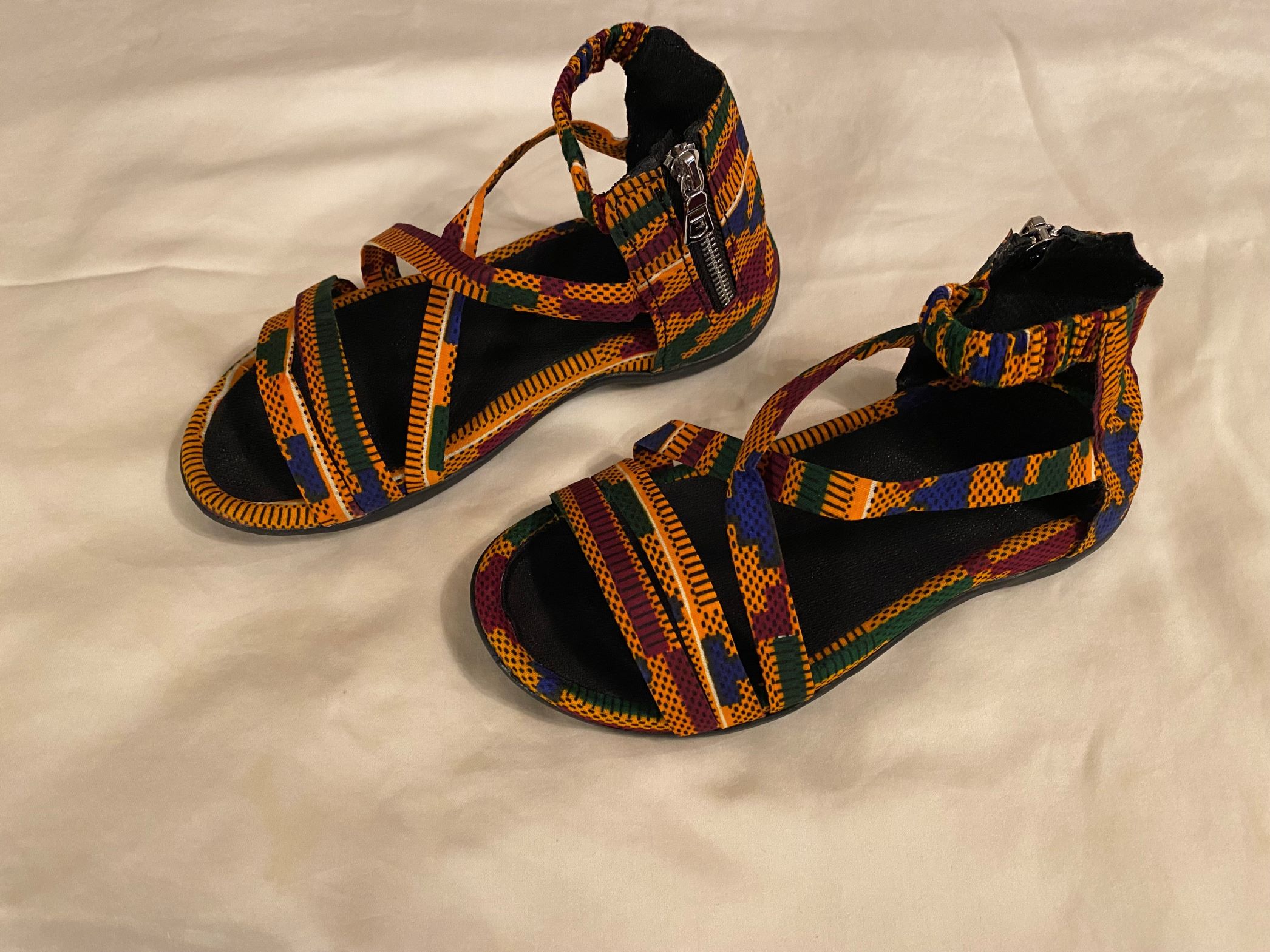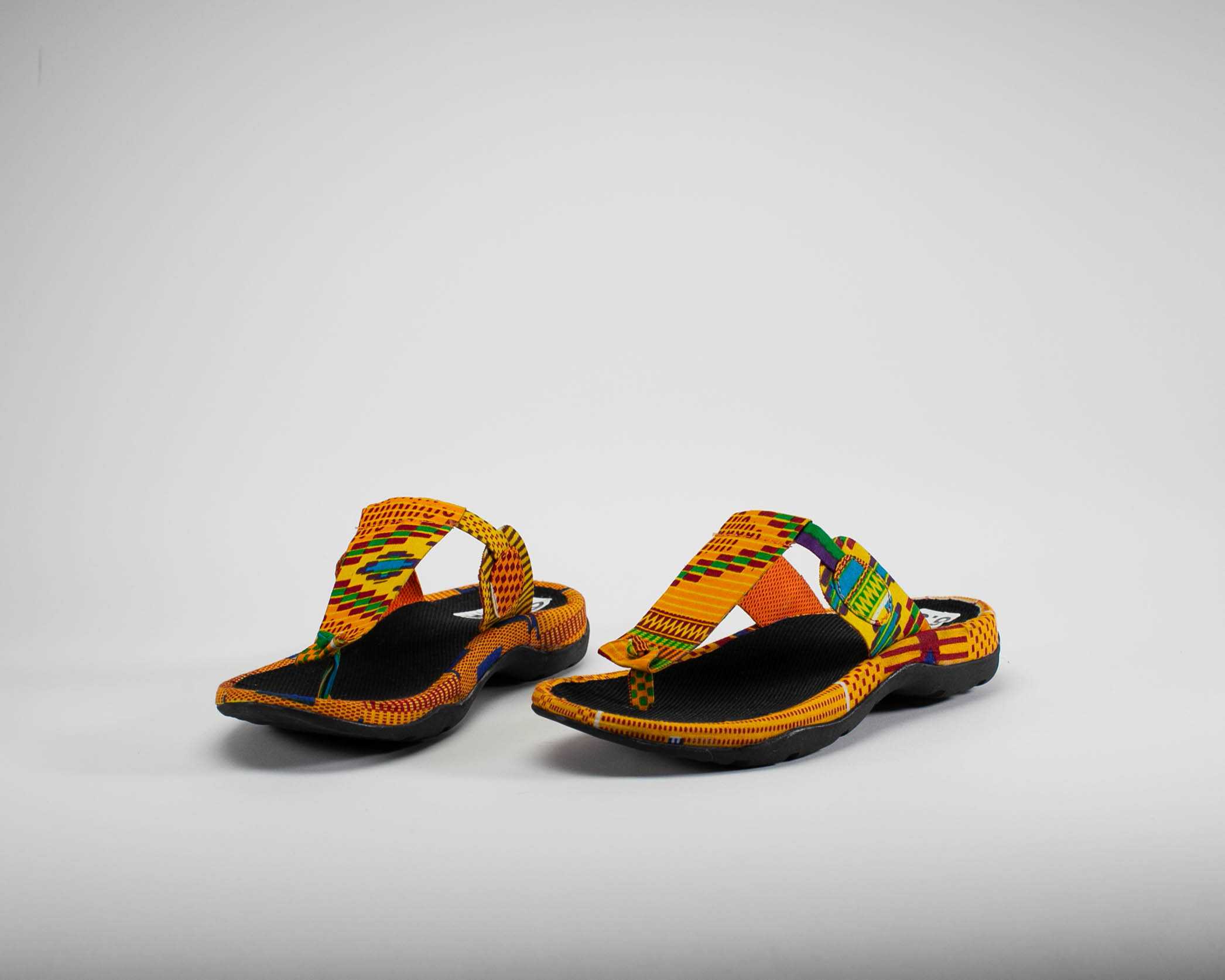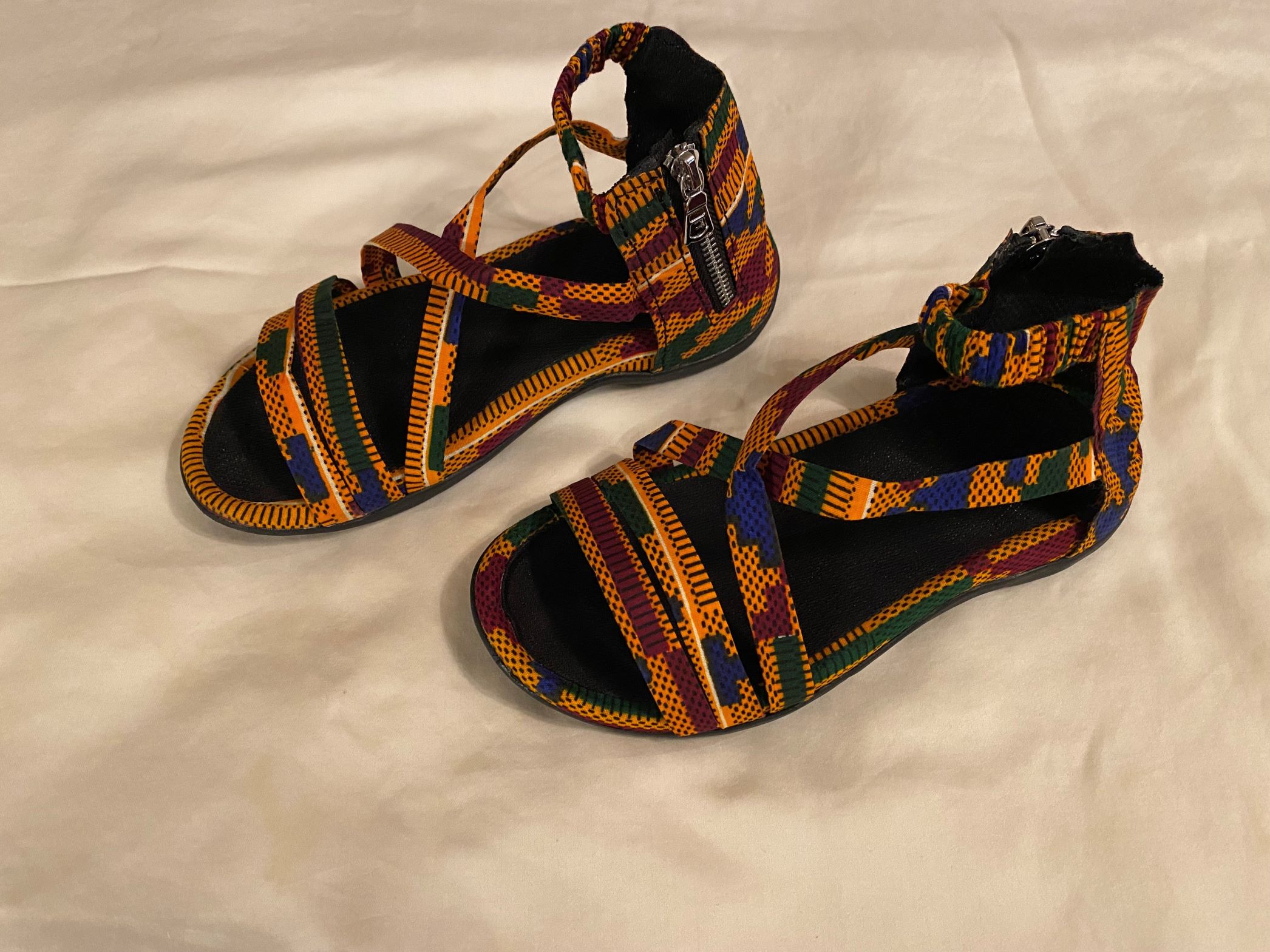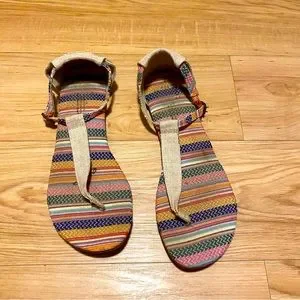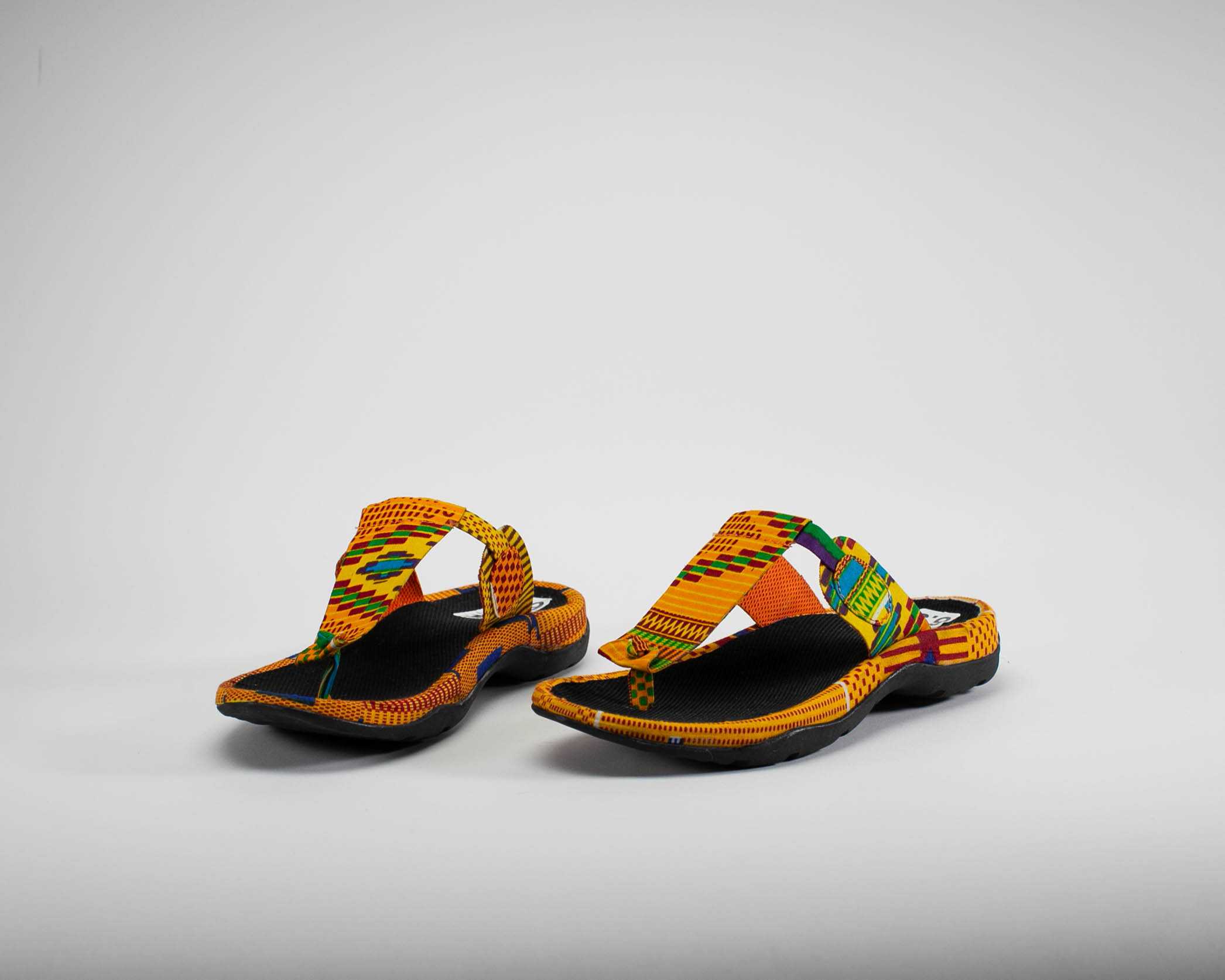Ewe traditional sandals, often referred to as "Dziku" in the Ewe language, play an important role in the cultural heritage of the Ewe people, who are predominantly found in the Volta Region of Ghana, southern Togo, and parts of Benin. These sandals are a reflection of Ewe craftsmanship, cultural values, and practical needs, blending traditional artistry with functionality.
1. Craftsmanship and Materials
Ewe sandals are traditionally handmade by local artisans using natural materials like leather, jute, or plant fibers. The leather is typically sourced from cattle or goats, treated, and processed into durable sandal straps and soles.
Skilled artisans are responsible for crafting the sandals, often using techniques passed down through generations. This traditional knowledge is an essential aspect of Ewe heritage, with each sandal representing the craftsmanship and creativity of the maker.
In some cases, artisans may incorporate beads or decorative stitching into the design, adding an aesthetic element to the sandals. Beaded decorations can symbolize beauty and cultural identity, while the stitching techniques may carry distinct patterns or symbolic meanings.
2. Cultural Significance
In Ewe culture, sandals are more than just footwear; they have social and cultural meanings attached to them. Certain styles of sandals might be worn for different occasions, such as festivals, ceremonies, or daily activities.
During cultural festivals like "Hogbetsotso," which commemorates the migration of the Ewe people, traditional sandals are often worn as part of the full cultural attire. These events highlight the importance of traditional clothing and footwear in expressing cultural pride and identity.
The sandals can also be worn during rites of passage, such as initiation ceremonies, weddings, and funerals. Depending on the occasion, the sandals may be adorned differently to suit the event’s mood and significance.
3. Design Features and Symbolism
Ewe traditional sandals often have a simple design, with a flat sole and straps that secure the sandal to the foot. However, artisans may add decorative elements like beadwork, colored stitching, or embossed patterns to personalize the sandals.
The use of natural colors like brown, black, or tan reflects the connection to the natural environment, while more colorful embellishments can symbolize joy, celebration, or social status.
Some sandals may feature symbols or patterns unique to the Ewe people, such as motifs inspired by local folklore, traditional proverbs, or ancestral symbols. This adds a layer of cultural meaning to the footwear, making it more than just a practical item.
4. Modern Adaptations and Cultural Revival.
In recent times, there has been a resurgence of interest in traditional Ewe sandals, with younger generations embracing them as a symbol of cultural pride and identity. Artisans are blending traditional techniques with modern fashion trends to create sandals that appeal to contemporary tastes while retaining their cultural essence.
Designers may experiment with new materials, such as recycled rubber or synthetic leather, to make the sandals more affordable or eco-friendly, while still incorporating traditional Ewe designs.
Efforts to preserve and promote Ewe sandal-making traditions include cultural fairs, exhibitions, and workshops that teach younger people the skills required for this traditional craft. This helps to keep the art form alive and fosters cultural pride among the community.
5. Economic and Social Impact
The production and sale of traditional sandals contribute to the local economy, providing a source of income for artisans and vendors. It also supports cultural tourism, as visitors to the Volta Region often purchase traditional Ewe sandals as souvenirs.
Artisans who make these sandals are often respected members of the community, as they play a role in preserving cultural heritage and passing on traditional knowledge to the next generation.
6. Contemporary Usage and Fashion
Today, Ewe sandals are not just worn within the community; they are also appreciated by people across Ghana and internationally for their unique style and cultural significance. They are sometimes paired with other traditional Ewe attire, such as "Kente" or "Agbada," to create a complete cultural look.
Modern fashion trends have seen the integration of Ewe sandals into various outfits, blending traditional elements with everyday wear. This helps to promote cultural heritage while keeping the traditional craft relevant in a modern context.
Ewe traditional sandals are more than just footwear; they are a representation of cultural heritage, craftsmanship, and the enduring traditions of the Ewe people. As symbols of identity and artistry, these sandals connect the past with the present, showcasing the beauty and resilience of Ewe culture.
TYPES OF EWE SANDALS
Ewe traditional sandals, known as "Dziku," come in various styles and designs, each serving different purposes and reflecting cultural significance. Here are some common types of Ewe local sandals:
1. Flat Sandals (Dziku)
Description: These are the most common type of Ewe sandals, typically made from leather or woven plant fibers. They feature a simple flat sole and are designed for everyday wear.
Use: Flat sandals are practical and comfortable, suitable for daily activities and informal occasions. They are often worn during festivals, markets, and casual outings.
2. Strap Sandals
Description: These sandals have multiple straps that secure the foot, often crossing over the instep or around the ankle. They may be made from leather or woven materials, featuring decorative elements like beads or colorful stitching.
Use: Strap sandals are popular for both casual and semi-formal occasions, providing more support than flat sandals while maintaining a traditional aesthetic.
3. Beaded Sandals
Description: Beaded sandals incorporate colorful beads into the design, either along the straps or on the sole. The beadwork can be intricate, showcasing local artistry and creativity.
Use: These sandals are often worn during cultural events, weddings, and celebrations, where their decorative nature adds to the festive attire.
4. Ankle-strap Sandals
Description: These sandals feature a strap that wraps around the ankle, providing additional support and stability. They may come in various styles, from simple designs to more elaborate versions with decorations.
Use: Ankle-strap sandals are often preferred for formal occasions or traditional ceremonies, as they can be paired with cultural attire and provide a more polished look.
5. Moccasin-style Sandals
Description: This style resembles traditional moccasins, with a soft, flexible design that may cover more of the foot. They are usually made from leather and feature stitching details.
Use: Moccasin-style sandals offer comfort and are often worn during informal gatherings or cultural events, providing a relaxed yet stylish option.
6. Outdoor Sandals
Description: These sandals are designed for durability and traction, often featuring thicker soles and sturdier materials. They may include elements such as raised treads for better grip.
Use: Outdoor sandals are suitable for walking on uneven terrain or during outdoor activities and events. They are practical for rural settings and traditional ceremonies held outdoors.
7. Decorative Ceremony Sandals
Description: These sandals are specially designed for important ceremonies and events, often featuring elaborate designs, vibrant colors, and decorative elements like embroidery or embellishments.
Use: Worn during significant cultural events, weddings, and festivals, these sandals enhance the traditional attire and reflect the wearer's social status and cultural pride.
Description: Smaller versions of traditional sandals designed specifically for children, often featuring playful colors and designs.
Use: These sandals are worn by children for everyday activities, cultural events, and festivals, helping to instill a sense of cultural identity from a young age.
Cultural Context and Significance
Each type of Ewe sandal carries cultural significance, representing the identity and traditions of the Ewe people. The materials used, the craftsmanship involved, and the designs reflect local resources, artistic skills, and social meanings.
Sandals are often worn during festivals such as Hogbetsotso and other cultural celebrations, reinforcing community bonds and cultural pride.
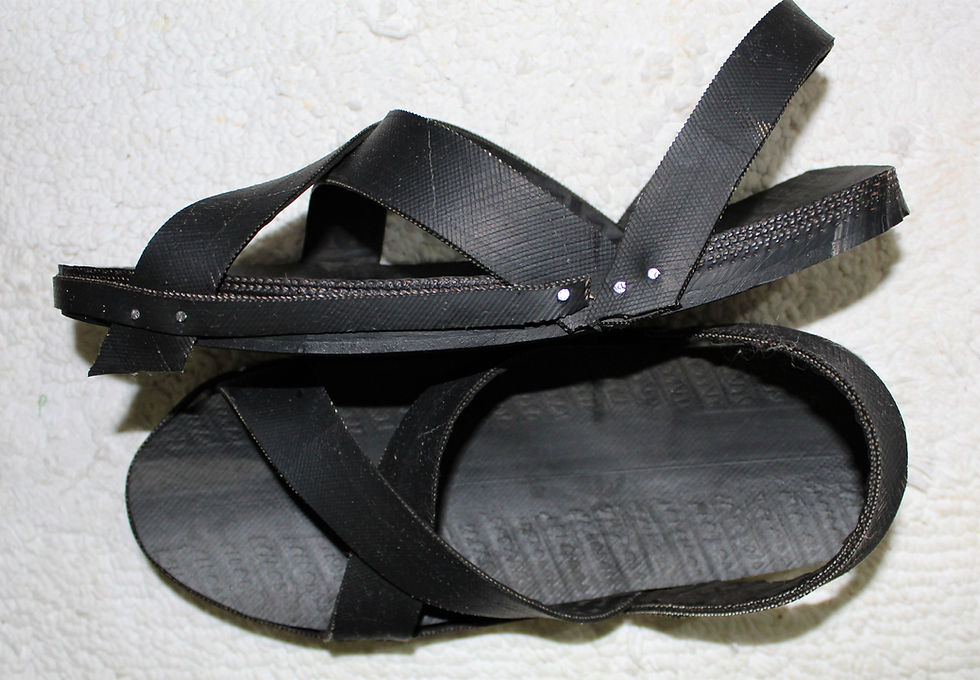 Ewe local sandals, with their various types and designs, highlight the craftsmanship and cultural heritage of the Ewe people, blending functionality with traditional artistry.
Ewe local sandals, with their various types and designs, highlight the craftsmanship and cultural heritage of the Ewe people, blending functionality with traditional artistry.

